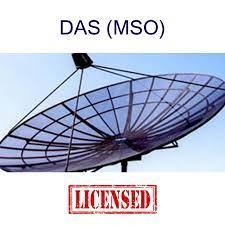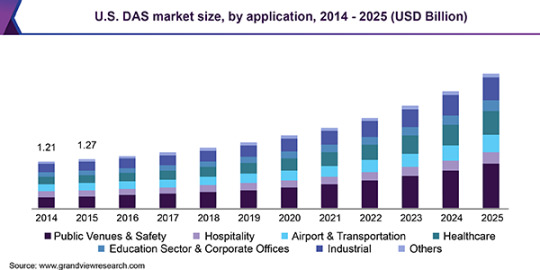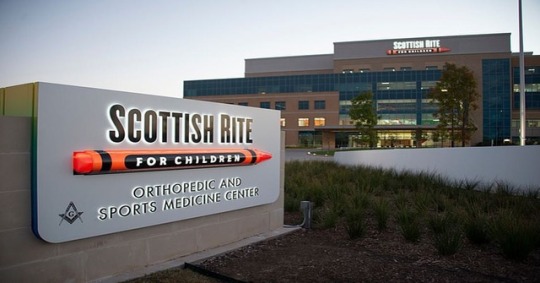#DistributedAntennaSystems
Explore tagged Tumblr posts
Text
Unlocking Opportunities in the Indian Broadcasting Industry: The Importance of the DAS MSO License

Introduction to the Indian broadcasting industry
India is home to one of the largest and most vibrant broadcasting industries in the world. With a population of over 1.3 billion people, the demand for television and cable services is immense. The Indian broadcasting industry has evolved significantly over the years, with the introduction of new technologies and regulations. In this article, we will explore the importance of the DAS MSO license in the Indian broadcasting industry and how it unlocks opportunities for cable TV operators.
What is a DAS MSO license?
Before we delve into the importance of the DAS MSO license, let's first understand what it is. DAS stands for "Digital Addressable System," and MSO stands for "Multi-System Operator." A DAS MSO license is a permit issued by the Ministry of Information and Broadcasting in India, which allows cable TV operators to transmit digital signals and provide cable services to subscribers.
Importance of the DAS MSO license for cable TV operators
The DAS MSO license is of paramount importance for cable TV operators in India. With the transition from analog to digital broadcasting, the government has made it mandatory for all cable TV operators to obtain a DAS MSO license. This license ensures that cable TV operators comply with the regulations set by the government and provide high-quality, encrypted digital signals to their subscribers.
The DAS MSO license also opens up a world of opportunities for cable TV operators. It allows them to offer a wide range of channels and services to their subscribers, including high-definition channels, interactive services, and video-on-demand. With a DAS MSO license, cable TV operators can tap into the growing demand for digital content and provide their subscribers with an enhanced viewing experience.
Regulations and guidelines for obtaining a DAS MSO license in India
Obtaining a DAS MSO license in India involves adhering to certain regulations and guidelines set by the Ministry of Information and Broadcasting. The government has laid out a comprehensive framework to ensure that cable TV operators meet the requirements and operate within the legal framework.
To obtain a DAS MSO license, cable TV operators need to fulfill certain eligibility criteria, including having a minimum net worth, technical expertise, and infrastructure. They also need to comply with guidelines related to signal quality, subscriber management, and content regulation. Additionally, cable TV operators are required to submit an application form along with the necessary documents and fees.
Steps to get a DAS MSO license
The process of obtaining a DAS MSO license in India involves several steps. Here is a step-by-step guide to help cable TV operators navigate through the application process:
Gather the necessary documents: Cable TV operators need to collect and organize all the required documents, including proof of identity, proof of address, financial statements, technical specifications, and infrastructure details.
Fill out the application form: Cable TV operators need to fill out the DAS MSO license application form accurately and provide all the necessary information.
Apply: Once the application form is complete, cable TV operators need to submit it along with the required documents to the Ministry of Information and Broadcasting.
Pay the fees: Cable TV operators are required to pay the prescribed fees for processing the DAS MSO license application. The fees may vary depending on the nature and size of the operation.
Await the approval: After applying, cable TV operators need to wait for the Ministry of Information and Broadcasting to review and process their application. This may take some time, and operators should be prepared for a waiting period.
Comply with inspections: As part of the application process, cable TV operators may be subject to inspections by government authorities to ensure compliance with regulations and guidelines. Operators should be prepared to cooperate with the authorities during these inspections.
Cost and fees associated with obtaining a DAS MSO license
Obtaining a DAS MSO license comes with certain costs and fees that cable TV operators need to be aware of. The fees associated with the license may vary depending on factors such as the number of channels offered, the size of the operation, and the region of operation. Cable TV operators should budget for the application fees, processing fees, and any other charges that may be applicable during the license acquisition process.
Operators need to consider these costs and fees while planning their budget and business model. However, despite the initial investment, the benefits of having a DAS MSO license far outweigh the costs, as it allows operators to tap into a vast market and offer a wide range of services to their subscribers.
DAS MSO license application process and requirements
The application process for a DAS MSO license in India involves fulfilling certain requirements and following specific guidelines. The Ministry of Information and Broadcasting has laid out a clear framework to ensure that cable TV operators meet the necessary criteria and operate within the legal framework.
To apply for a DAS MSO license, cable TV operators need to provide proof of identity, proof of address, financial statements, technical specifications, infrastructure details, and other relevant documents. They also need to pay the prescribed fees and submit the application form along with all the required documents. Once the application is submitted, operators need to await approval from the Ministry of Information and Broadcasting.
Benefits of having a DAS MSO license
Having a DAS MSO license offers numerous benefits for cable TV operators in the Indian broadcasting industry. Some of the key benefits include:
Expanded channel offerings: With a DAS MSO license, cable TV operators can offer a wide range of channels to their subscribers, including high-definition channels, regional channels, and niche content.
Enhanced viewer experience: The digital transmission enabled by a DAS MSO license ensures high-quality, encrypted signals, providing subscribers with a superior viewing experience.
Access to interactive services: With a DAS MSO license, cable TV operators can provide interactive services such as video-on-demand, interactive games, and personalized content recommendations, enhancing subscriber engagement.
Revenue generation: The DAS MSO license opens up new revenue streams for cable TV operators through advertising, subscription fees, and value-added services.
Challenges and considerations for MSOs in the Indian broadcasting industry
While the DAS MSO license brings numerous opportunities, cable TV operators also face certain challenges and considerations in the Indian broadcasting industry. Some of these include:
Competition: The Indian broadcasting industry is highly competitive, with multiple MSOs vying for subscribers. Cable TV operators need to differentiate themselves and offer unique services to stay ahead in the market.
Technological advancements: With rapid advancements in technology, cable TV operators need to keep up with the latest trends and upgrade their infrastructure to stay relevant.
Content acquisition: Acquiring content rights can be a complex and expensive process for cable TV operators. They need to negotiate deals with content providers and ensure compliance with copyright laws.
Regulatory compliance: Cable TV operators need to stay updated with the latest regulations and guidelines set by the Ministry of Information and Broadcasting to avoid any legal complications.
Conclusion: Leveraging the opportunities with a DAS MSO license
The Indian broadcasting industry offers immense opportunities for cable TV operators, and a DAS MSO license is the key to unlocking these opportunities. By obtaining a DAS MSO license, operators can expand their channel offerings, provide enhanced services to subscribers, and tap into new revenue streams. While there are challenges and considerations to navigate, the benefits of having a DAS MSO license far outweigh the costs. Cable TV operators should seize this opportunity to leverage the potential of the Indian broadcasting industry and provide a superior viewing experience to their subscribers.
#DAS#DAS LICENSE#DASLICENSE#DASNETWORKS#DISTRIBUTEDANTENNASYSTEMS#FCCCOMPLIANCE#LICENSE#MSOCOMPLIANCE#MSOLICENSE#MSOREGULATION#REGISTRATION#SPECTRUMLICENSING#SPECTRUMMANAGEMENT#TELECOMLAWS#TELECOMLICENSING#TELECOMREGULATION#WIRELESSCOMPLIANCE#WIRELESSINFRASTRUCTURE
0 notes
Text
Distributed Antenna System (DAS) Market Future Trends: Innovations and Growth Opportunities in Wireless Connectivity
The Distributed Antenna System (DAS) market future trends indicate a dynamic evolution driven by growing demand for robust wireless connectivity in indoor and dense urban environments. DAS technology, designed to improve cellular coverage and capacity by distributing signals through multiple antennas, is increasingly vital as mobile data traffic soars and next-generation networks emerge.
This article explores the future trends shaping the DAS market, highlighting technological innovations, growing applications, regional developments, and strategic market shifts that are expected to define the industry’s growth in the coming years.

Rising Demand for Enhanced Indoor Connectivity
One of the core drivers for the DAS market is the growing necessity for reliable indoor wireless coverage. Traditional cell towers often fail to provide adequate signal penetration in large buildings, stadiums, airports, hospitals, and commercial complexes.
Trend Toward High-Capacity Venues: With the increase in events and gatherings, venues such as sports arenas, convention centers, and transportation hubs require enhanced connectivity solutions to support thousands of simultaneous users. DAS systems are evolving to offer higher capacity and seamless handoff capabilities.
Smart Building and Campus Deployments: The integration of DAS with smart building technologies is becoming a significant trend. Organizations aim to ensure uninterrupted connectivity for IoT devices, security systems, and mobile users within corporate campuses and educational institutions, pushing DAS demand.
Integration with 5G Networks
The rollout of 5G networks is one of the most transformative factors influencing DAS market future trends.
5G-Ready DAS Solutions: Future DAS deployments are being designed to support 5G’s higher frequency bands and massive MIMO (multiple-input multiple-output) technology. This enables ultra-fast data speeds, lower latency, and improved network reliability indoors.
Hybrid Networks Combining DAS and Small Cells: To maximize coverage and capacity, hybrid solutions combining DAS with small cell networks are gaining popularity. This strategic integration addresses challenges such as limited spectrum and network densification required by 5G.
Support for Network Slicing and Private Networks: As 5G enables network slicing and dedicated private networks, DAS systems are adapting to provide customizable coverage tailored to specific business or industrial needs, particularly in manufacturing, logistics, and healthcare sectors.
Increasing Adoption Across Diverse Industries
The DAS market is expanding beyond traditional telecommunications to serve multiple verticals, reflecting broadening application scenarios.
Healthcare: Hospitals require reliable, secure wireless connectivity for critical medical equipment, patient monitoring, and emergency communication. DAS ensures consistent signal quality in complex building layouts and underground areas.
Transportation: Airports, train stations, and metro systems increasingly deploy DAS to enhance passenger connectivity, operational communications, and security systems.
Retail and Hospitality: To meet customer expectations for seamless mobile experiences, malls, hotels, and resorts implement DAS to boost coverage and enable location-based services.
Industrial and Manufacturing: Factories and warehouses use DAS to support IoT devices, automated guided vehicles (AGVs), and real-time monitoring systems, enhancing operational efficiency and safety.
Technological Innovations Influencing Future Trends
Advancements in DAS technology are key to market growth and adapting to evolving connectivity needs.
Cloud-Based and Software-Defined DAS: Future DAS systems leverage cloud platforms and software-defined networking (SDN) to enable remote management, flexible configuration, and scalability. This reduces deployment costs and improves system responsiveness.
Energy Efficiency and Green Technologies: New DAS designs focus on reducing power consumption and integrating with renewable energy sources, aligning with global sustainability goals.
Improved Security Features: As DAS networks handle sensitive data and critical communications, enhanced cybersecurity measures are being incorporated, including encryption, intrusion detection, and compliance with regulatory standards.
Regional Market Trends and Growth Opportunities
Regional developments strongly influence DAS market future trends, driven by infrastructure investments and government policies.
North America Leading in Advanced Deployments: The U.S. and Canada are at the forefront of adopting 5G-ready DAS, supported by substantial investments in smart city projects and enterprise networks.
Asia-Pacific’s Rapid Urbanization and Connectivity Needs: Countries like China, India, Japan, and South Korea are witnessing rapid urban growth, increasing demand for indoor wireless solutions. Government initiatives promoting digital infrastructure boost DAS deployment.
Europe’s Focus on Public Safety and Regulatory Compliance: Europe emphasizes secure and resilient communication networks, including DAS for public safety, emergency response, and transport systems.
Market Challenges and Adaptations
Despite promising trends, the DAS market faces challenges that require strategic responses.
High Initial Deployment Costs: Although long-term benefits are substantial, upfront investments for DAS installation can be significant, particularly for small and medium-sized enterprises.
Complex Integration and Maintenance: Deploying DAS in existing buildings requires careful planning to avoid disruption. Continuous maintenance and upgrades to keep pace with evolving network standards are necessary.
Competition from Alternative Technologies: Small cells, Wi-Fi 6, and emerging wireless solutions pose competitive threats. DAS providers must differentiate through superior performance, scalability, and integration capabilities.
Strategic Outlook for DAS Market Growth
The future of the DAS market is promising, characterized by innovation and expanding use cases. Providers focusing on developing flexible, scalable, and cost-effective DAS solutions tailored for 5G and beyond will capture significant market share.
Collaboration with telecom operators, infrastructure companies, and enterprise customers will be critical to delivering customized deployments. Embracing software-defined technologies and cloud integration will also enhance service agility.
Conclusion
The Distributed Antenna System (DAS) market future trends showcase a rapidly evolving landscape shaped by 5G adoption, industry diversification, and technological breakthroughs. As wireless connectivity becomes indispensable across all facets of life and business, DAS will play a pivotal role in ensuring seamless, high-quality indoor coverage worldwide. Stakeholders who anticipate these trends and invest in innovation will position themselves at the forefront of this expanding market.
0 notes
Text

#PBEaxell provided a #PublicSafety #TETRA system to the world's tallest building, while utilising the existing #fibre backbone within the building.
More info: https://pbeaxell.com/about/case-studies/burj-khalifa-coverage
#Dubai #dubailife #UAE #dubairealestate
#communications#das#wireless#5g#networks#cellular#comms#first responders#publicsafety#engineeringjobs#Dubai#UAE#0ff-airRepeater#DistributedAntennaSystem#coverage#BaseStation#4g#3g#2#2g#network#WirelessNetwork
0 notes
Photo

The proper configuration of dispersed antenna systems enables office clients or tenants to stay connected in an emergency. With the aid of this infographic, understand how a dispersed antenna system functions. You can read more information on how a spread antenna system disperses signals.
0 notes
Text
Distributed Antenna Systems Market Worth $13.78 Billion By 2025
The global distributed antenna systems market size is expected to reach USD 13.78 billion by 2025, according to a study conducted by Grand View Research, Inc. It is anticipated to register a CAGR of 11.4% during the forecast period. Key factors driving the demand for Distributed Antenna Systems (DAS) include proliferation of connected devices in Internet of Things (IoT), mobile data traffic, and demand for extended network coverage and constant connectivity. Additionally, an increase in higher-bandwidth applications and in-building demand is also supporting the market growth.

Increasing use of wireless data has been accompanied by the development of newer and faster mobile networks, such as 4G and 5G. These networks have become affordable due to their wide usage and availability of smartphones at affordable prices. Moreover, since the switching cost from one service provider to another is low, mobile network operators have to be extra cautious of the penetration and quality of their network. Increased emphasis on improving network performance has propelled service providers to opt for solutions such as DAS, to ensure round the clock availability of their network, thereby driving market growth.
However, the high cost of manufacturing along with the complex installation process of the system is expected to hamper the market growth. Cellular network providers are working on extending their network coverage and bandwidth to take into account the substantial costs involved in the development of a DAS system, which may be attributed to the high cost of consultation, planning and implementation along with the high product price itself.
To request a sample copy or view summary of this report, click the link below: https://www.grandviewresearch.com/industry-analysis/distributed-antenna-systems-das-market
Further key findings from the study suggest:
The hybrid DAS segment is expected to expand at a CAGR exceeding 14.0% over the forecast period. This system is an ideal fit for medium-sized spaces or areas with weak signals. It is cost-effective, easily expandable, and provides increased efficiency and broader coverage
The neutral-host ownership segment captured over 48.0% of the overall market share in 2018. This segment is projected to witness the highest growth on account of a large user base, third-party ownership, and a number of players providing a range of solutions
The public venues and safety segment is expected to emerge as the fastest-growing segment over the forecast period attributed to the high adoption of DAS solution in areas such as entertainment venues, sports stadiums, and shopping malls
North America accounted for over 30.0% of the market share in 2018. Meanwhile, Asia Pacific is expected to expand at the highest CAGR owing to the increasing sales of handheld devices and smartphones in China and India coupled with rising infrastructural growth
Key players in the DAS market include CommScope Inc.; Corning Inc.; Crown Castle International Corporation; and Boingo Wireless Inc., among others. These companies are engaging in collaborations with construction companies to sustain the competition.
See More Reports of This Category: https://www.grandviewresearch.com/industry/emerging-and-next-generation-technologies
About Grand View Research:
Grand View Research, Inc. is a U.S. based market research and consulting company, registered in the State of California and headquartered in San Francisco. The company provides syndicated research reports, customized research reports, and consulting services. To help clients make informed business decisions, we offer market intelligence studies ensuring relevant and fact-based research across a range of industries, from technology to chemicals, materials and healthcare.
0 notes
Photo

Walker Engineering's Technology Service Group performed technology installations at the Scottish Rite Rite Hospital for Children Orthopedic and Sports Medicine Center in Frisco, TX. http://bit.ly/2OH0ji4 . . . . . #WeAreWalker #TheWalkerWay #ProjectSpotlight #InTheNews #WalkerLeaders #InTheNews #Construction #innovation #Electrical #ServicesSpotlight #WalkerLeaders #TechnologyServices #ShooterDetection #structuredcable #audio #video #fiberopticcable #proaudio #securityaccesscontrol #distributedantennasystems #soundmasking #emergencycommunicationsystem #24hourEndUserService #TrustBuiltonPerformance https://www.instagram.com/p/Bv19DPhn1pB/?utm_source=ig_tumblr_share&igshid=1bql7xlsx296b
#wearewalker#thewalkerway#projectspotlight#inthenews#walkerleaders#construction#innovation#electrical#servicesspotlight#technologyservices#shooterdetection#structuredcable#audio#video#fiberopticcable#proaudio#securityaccesscontrol#distributedantennasystems#soundmasking#emergencycommunicationsystem#24hourenduserservice#trustbuiltonperformance
0 notes
Link
Dec 18, 2019 (The Expresswire) -- Global Distributed Antenna System Market - Premium Insight, Competitive News Feed Analysis, Company Usability Profiles, Market Sizing & Forecasts to 2025 The Distributed Antenna System research report provides global Industry insights which include market penetratio via Pocket
0 notes
Text
Distributed Antenna System (DAS) Market Drivers: Key Factors Fueling Growth and Adoption
The Distributed Antenna System (DAS) market is experiencing significant growth due to several key factors, including increasing demand for enhanced wireless coverage, the rise of mobile data usage, and the need for advanced communication infrastructure. DAS provides an effective solution for improving network connectivity in challenging environments where traditional antenna systems fail to meet requirements. This article explores the primary drivers behind the growing adoption of DAS across industries and regions.

1. Rising Demand for Seamless Connectivity
The increasing reliance on mobile devices and wireless communication has fueled the need for uninterrupted, high-quality network coverage. In densely populated areas such as stadiums, airports, and office buildings, traditional cellular networks often struggle to deliver optimal performance due to interference, signal degradation, and high user density. DAS solves these issues by deploying multiple antennas throughout a building or area, ensuring consistent, reliable coverage even in areas with challenging signal environments.
As the number of connected devices continues to grow, the demand for reliable and high-speed connectivity has become a key driver for the DAS market. Businesses and institutions are investing in DAS technology to offer better experiences to users while avoiding connectivity bottlenecks.
2. Increasing Mobile Data Traffic
The exponential growth of mobile data traffic, driven by the widespread use of smartphones, tablets, and connected devices, is a major contributor to the expansion of the DAS market. According to industry reports, mobile data traffic is expected to increase several times over the next decade. This surge in data traffic places enormous pressure on traditional network infrastructure to meet the demands of consumers and businesses.
DAS allows network operators to improve data throughput and alleviate congestion by distributing the load across multiple antennas. By providing more targeted and efficient coverage, DAS can support the growing data demands of users, enabling faster speeds and enhanced connectivity in crowded environments.
3. 5G Deployment and Technological Advancements
The rollout of 5G networks is a significant driver of growth in the DAS market. 5G technology promises faster speeds, lower latency, and higher network capacity, but it also requires more dense and distributed infrastructure to function effectively. Traditional antenna systems may not be capable of handling the high-frequency bands that 5G demands, especially in urban areas or indoor environments.
DAS provides a scalable and flexible solution for supporting 5G deployments by distributing the antennas needed to deliver high-frequency signals across a network. As 5G adoption accelerates, the need for advanced DAS solutions to support the new generation of wireless communication will continue to drive market growth.
4. Urbanization and Infrastructure Development
Urbanization is another important factor driving the DAS market. As cities continue to grow and develop, the demand for robust communication infrastructure increases. In urban environments with high-rise buildings, tunnels, and underground areas, it is often difficult for traditional antenna systems to provide adequate coverage.
DAS allows for precise signal distribution in these complex environments by strategically placing antennas throughout the area. This is particularly important in large commercial buildings, hotels, airports, and other high-traffic locations where users expect consistent, high-quality network performance.
Furthermore, the construction of new smart cities and infrastructure projects is expected to boost the demand for DAS solutions as these areas require reliable and high-performance wireless networks.
5. Increased Focus on Public Safety
Public safety is another significant driver of the DAS market, particularly in areas where emergency services rely on communication networks to function efficiently. DAS can enhance public safety by ensuring that first responders and emergency services personnel maintain uninterrupted access to wireless networks during critical situations.
Many government regulations require buildings, transportation systems, and other critical infrastructure to implement robust communication systems that support emergency services. As a result, DAS is being increasingly adopted in hospitals, public transportation systems, and other public facilities to improve safety and communication reliability.
6. Cost-Effectiveness of DAS Solutions
The cost-effectiveness of DAS is an attractive factor for businesses looking to enhance wireless connectivity without investing in large-scale infrastructure upgrades. Unlike traditional cellular networks, DAS does not require the installation of large, expensive towers. Instead, it utilizes smaller, more affordable antennas that can be distributed throughout a building or area.
DAS allows businesses to maximize their existing infrastructure by enhancing coverage with relatively low operational costs. This is particularly appealing for small to medium-sized enterprises (SMEs) and other organizations with limited budgets but high demands for reliable connectivity.
7. Growth in the Hospitality and Retail Sectors
The hospitality and retail industries are increasingly adopting DAS to improve customer experiences by providing reliable wireless coverage in hotels, resorts, shopping malls, and retail stores. Customers expect seamless connectivity while they shop, dine, or stay in hotels, and businesses are recognizing the importance of providing excellent wireless service to stay competitive.
In the retail sector, DAS can support services such as mobile payments, inventory management, and location-based marketing, helping retailers improve operational efficiency and customer engagement.
Conclusion
The Distributed Antenna System (DAS) market is driven by several factors that make it an essential component of modern wireless communication infrastructure. From the need for improved connectivity and increased mobile data traffic to the advancements in 5G technology and urbanization, DAS plays a crucial role in meeting the demands of today’s connected world. As businesses and industries continue to invest in cutting-edge communication technologies, the DAS market will remain a key player in ensuring efficient and reliable wireless coverage for years to come.
0 notes
Text
PBE Axell is revolutionising #Airport#Connectivity with our state-of-the-art
#DistributedAntennaSystems (#DAS).
Wider #Coverage: #SeamlessConnectivity across vast airport environments.
Increased Control: Precision in #network management for optimal performance.
Higher Capacity: Robust systems built to handle high demand efficiently.
Enhanced Performance: Designed to meet market and #PublicSafety requirements.
Join #PBEAxell in setting a new standard for #AirportConnectivity.
Learn more about our innovative DAS solutions here: https://lnkd.in/d2Ktg5Sq
#Telecommunications#AirportManagement#ConnectivitySolutions
#communications#5g#cellular#networks#das#wireless#comms#first responders#publicsafety#airports#airportmanagers#airportcommunications
1 note
·
View note
Text
DAS Protocols
PBE Axell #DAS architecture is uniquely crafted to provide a competitive edge. Experience enhanced user satisfaction with our advanced, scalable, and multi-operator #DistributedAntennaSystems for superior #Wirelesscoverage in #PublicSafety and #Cellular applications.
#Communications#DAS#Distributed Antenna Systems#5G#Comms#Connectivity#Networks#5GNetworks#Cellular#PublicSafety
0 notes
Photo

Walker is installing the cellular DAS (Distrubuted Anntena System) including cabling, antennas, chassis and head-end equipment on the 10 floors, sectors 1, 2 , 3, 4 & 5 at the Pioneer Natural Resources new headquarters in Irving, Texas. Walker has teamed up with RF Connect for the programming & commissioning of the system, along with the carrier negotiations with AT&T, Verizon & T-Mobile. http://bit.ly/2GqrLPR . . . . . #WeAreWalker #TheWalkerWay #ServicesSpotlight #WalkerLeaders #Construction #innovation #Electrical #TechnologyServices #ShooterDetection #structuredcable #audio #video #fiberopticcable #proaudio #securityaccesscontrol #distributedantennasystems #soundmasking #emergencycommunicationsystem #24hourEndUserService #TrustBuiltonPerformance (at Irving, Texas) https://www.instagram.com/p/Bt62-zwnMTo/?utm_source=ig_tumblr_share&igshid=1pnr9o6vazf4g
#wearewalker#thewalkerway#servicesspotlight#walkerleaders#construction#innovation#electrical#technologyservices#shooterdetection#structuredcable#audio#video#fiberopticcable#proaudio#securityaccesscontrol#distributedantennasystems#soundmasking#emergencycommunicationsystem#24hourenduserservice#trustbuiltonperformance
0 notes
Video
instagram
Technology Services Made Simple! Walker Engineering provides a single source solution for all of your commercial technology projects and end-user services. https://buff.ly/2RRhvBH⠀ ⠀ #WeAreWalker #TheWalkerWay #ServicesSpotlight #WalkerLeaders #Construction #innovation #Electrical #TechnologyServices #ShooterDetection #structuredcable #audio #video #fiberopticcable #proaudio #securityaccesscontrol #distributedantennasystems #soundmasking #emergencycommunicationsystem #24hourEndUserService #TrustBuiltonPerformance (at Walker Engineering, Inc.) https://www.instagram.com/p/BtwMm7Ln2d9/?utm_source=ig_tumblr_share&igshid=1iwmxzq0ks03i
#wearewalker#thewalkerway#servicesspotlight#walkerleaders#construction#innovation#electrical#technologyservices#shooterdetection#structuredcable#audio#video#fiberopticcable#proaudio#securityaccesscontrol#distributedantennasystems#soundmasking#emergencycommunicationsystem#24hourenduserservice#trustbuiltonperformance
0 notes
Photo

Join us in congratulating Walker Engineering's Technology Services project team from the Scottish Rite Hospital for Children Orthopedic and Sports Medicine Center in Frisco, TX. Walker received a Merit Award for this year’s Distinguished Building Awards competition in the Specialty Contractor “Other Specialty (All Contract Amounts)” category. Project Info: 345,000 SQFT facility on 40 acres. Walker performed technology installations including structured cabling, nurse call systems, DAS, television systems, physiological monitoring systems, intrusion detection, access control, intercom system, and video surveillance system. . . . . . #WeAreWalker #TheWalkerWay #ProjectSpotlight #InTheNews #WalkerLeaders #InTheNews #Construction #innovation #ServicesSpotlight #WalkerLeaders #Construction #innovation #TechnologyServices #ShooterDetection #structuredcable #audio #video #fiberopticcable #proaudio #securityaccesscontrol #distributedantennasystems #soundmasking #emergencycommunicationsystem #24hourEndUserService #TrustBuiltonPerformance (at Texas Scottish Rite Hospital For Children) https://www.instagram.com/p/BvzYcYuHC0h/?utm_source=ig_tumblr_share&igshid=g42o11kgb19u
#wearewalker#thewalkerway#projectspotlight#inthenews#walkerleaders#construction#innovation#servicesspotlight#technologyservices#shooterdetection#structuredcable#audio#video#fiberopticcable#proaudio#securityaccesscontrol#distributedantennasystems#soundmasking#emergencycommunicationsystem#24hourenduserservice#trustbuiltonperformance
0 notes
Video
instagram
Technology Services Made Simple! Walker Engineering provides a single source solution for all of your commercial technology projects and end-user services. https://buff.ly/2RRhvBH⠀ ⠀ #WeAreWalker #TheWalkerWay #ServicesSpotlight #WalkerLeaders #Construction #innovation #Electrical #TechnologyServices #ShooterDetection #structuredcable #audio #video #fiberopticcable #proaudio #securityaccesscontrol #distributedantennasystems #soundmasking #emergencycommunicationsystem #24hourEndUserService #TrustBuiltonPerformance (at Walker Engineering, Inc.) https://www.instagram.com/p/BtwMm7Ln2d9/?utm_source=ig_tumblr_share&igshid=1n2u9csig6ggt
#wearewalker#thewalkerway#servicesspotlight#walkerleaders#construction#innovation#electrical#technologyservices#shooterdetection#structuredcable#audio#video#fiberopticcable#proaudio#securityaccesscontrol#distributedantennasystems#soundmasking#emergencycommunicationsystem#24hourenduserservice#trustbuiltonperformance
0 notes